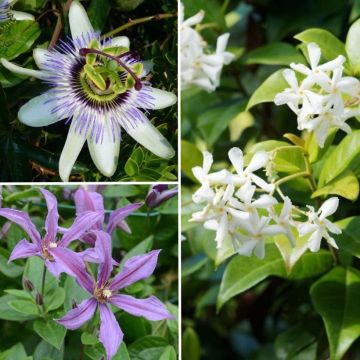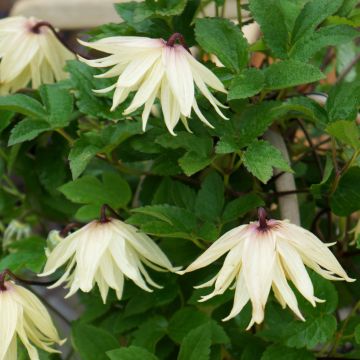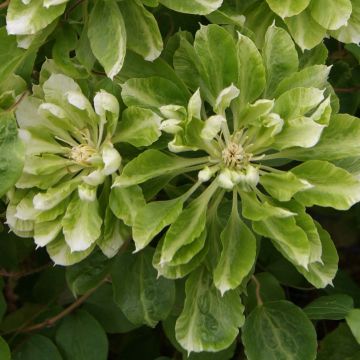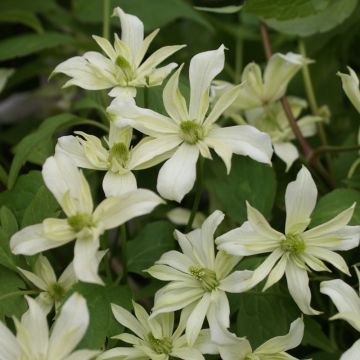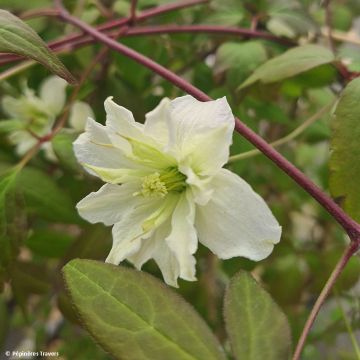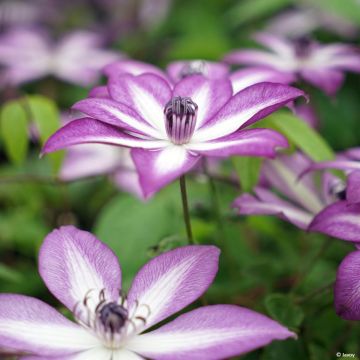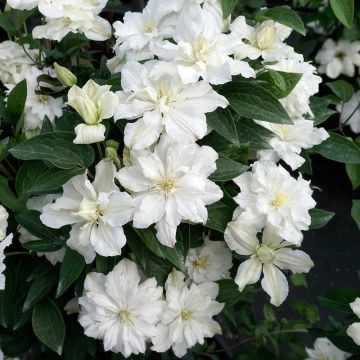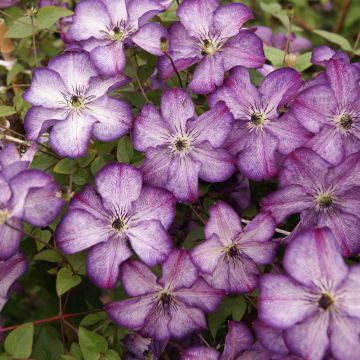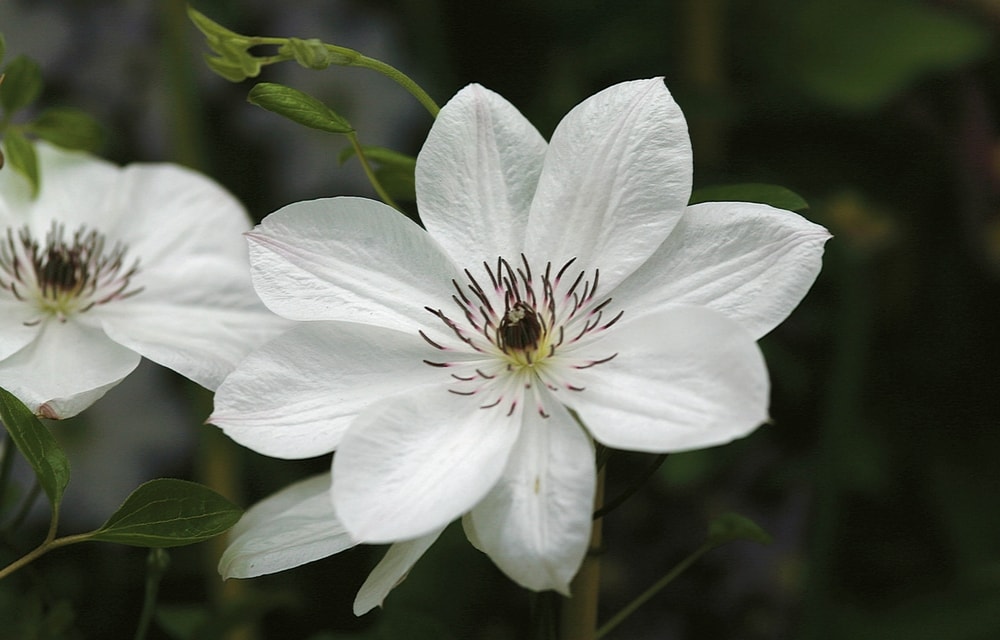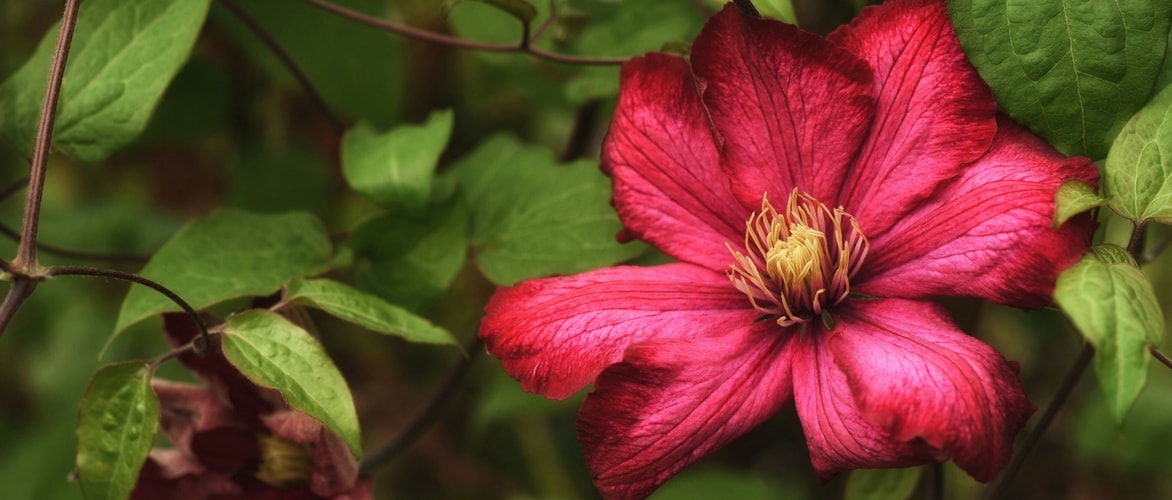
Clematis: planting, pruning and care
Contents
Clematis in a nutshell
- Clematis are famous for their star-shaped flowers, which can be fragrant
- These young plants offer a wide range of colours and shapes, ideal for all garden styles
- Their delicate appearance adds a romantic touch, especially when paired with other plants like roses
- Some, such as Clematis armandii and Clematis cirrhosa, retain their foliage all year round
- Perfect for small spaces, they can be grown in pots to enhance terraces and balconies
A word from our Expert
Clematis is a climbing plant that has much to offer, but it also requires a certain level of attention. Its spectacular flowering makes it the queen of climbing plants, capable of transforming any space into a fairy-tale garden. The different varieties allow for staggered flowering, ensuring a colourful display almost all year round.
However, clematis has its requirements: it loves the sun but needs its roots to be in the shade. The soil must be well-drained while remaining cool, which may require mulching. It is also susceptible to certain diseases and parasites, so regular monitoring is advisable.
Pruning is another aspect not to be overlooked. Depending on the variety, it may require pruning just after flowering or at the end of spring for large-flowered varieties. Proper pruning will encourage a more abundant and healthier flowering.
Finally, let’s not forget that clematis needs a sturdy support for its voluble stems. Whether it’s a pergola, a fence, or even a tree, make sure to provide adequate support. For those short on space, the good news is that it can also be grown in pots, making it ideal for terraces and balconies.
Clematis Botany: a fascinating diversity
Botanical data
- Latin name Clematis sp.
- Family Ranunculaceae
- Common name Clematis
- Flowering from March for early varieties, and until October
- Height from 2 to 15 metres
- Exposure flowers in the sun and roots in the shade
- Soil type deep, cool, well-drained
- Hardiness -20 °C for most varieties
Clematis count nearly 300 species and 400 horticultural varieties! It is a highly diverse genus in terms of forms, as it includes climbing plants, small perennials, as well as bushes. The most common in gardens are climbing plants with large flowers, but non-climbing clematis are also cultivated.
They are native to Europe, Asia, Australia, and North and Central America. Many species come from China. In France, the Hedge Clematis, Clematis vitalba, is a common plant in hedges and clearings. You have surely encountered it! Its particularly long and flexible stems are used for basketry.
It belongs to the family of ranunculaceae, which includes 1,500 species such as hellebores, delphiniums, and columbines. Its name comes from the Greek Klema, which designates a flexible branch, a vine-plant.
The clematis is a fast-growing climbing plant. Its petioles form tendrils that wrap around the support. Therefore, it needs a support or trellis and cannot climb directly against a wall, unlike ivy which clings on its own thanks to its climbing roots.
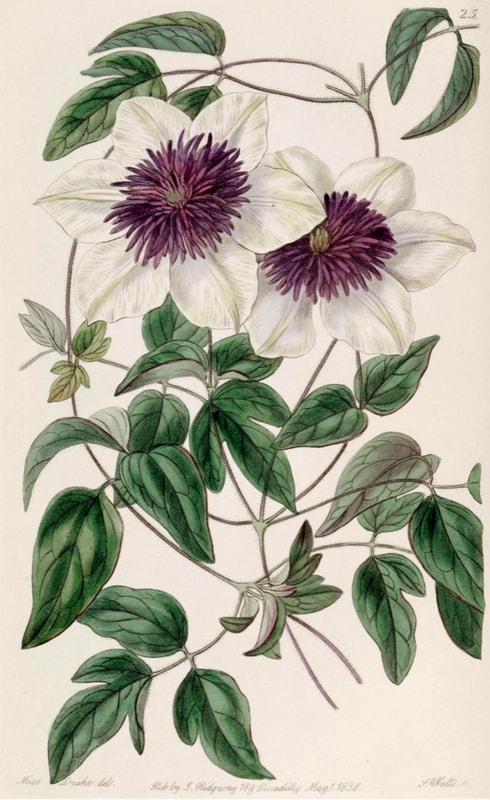
Clematis florida ‘Sieboldii’: botanical plate
Most varieties measure between two and four metres in height, but the tallest can reach up to 15 metres high. There are also non-climbing clematis, which are grown as perennials. This is the case for Clematis heracleifolia, Clematis integrifolia, and Clematis recta. The stems of clematis can also crawl on the ground or fall over the edge of a pot.
For our greatest pleasure, clematis offer an extraordinary diversity in terms of flowers! They can either disappear under a cascade of exuberant flowers in bright colours or bear small delicate and discreet flowers, very cute, like Clematis fusca. The flowers of the waxy clematis, Clematis cirrhosa, surprise us with their originality! They are small and bicoloured, white speckled with purple spots… nothing like those of the most common varieties! The botanical species and varieties with bell-shaped flowers have a particularly natural and wild aspect. The diameter of the flowers varies greatly, from two centimetres for the smallest to about twenty centimetres for some hybrids.
The flowers of clematis take on very varied shapes. Simple flowers have a rather sober and natural appearance, while double flowers seem much more sophisticated. The clematis from the Atragene group form small bell-shaped flowers in spring, quite light, which gives them a lot of charm! The flowers can be very original, like those of the variety ‘Octopus’, whose long purple sepals seem to go in all directions. Some clematis also take the shape of tulip flowers.
Contrary to what one might think, it is not the petals that are coloured, but the sepals. Each flower has between four and ten. They are often pink, white, blue, or purple, sometimes red. This gives the plant a soft and romantic aspect. The flowers can also be yellow, like those of Clematis tangutica. Often, the stamens are long and decorative. When the sepals take on a dark hue, they sometimes offer a superb contrast!
Some clematis offer fragrant flowers, like Clematis armandii ‘Apple Blossom’ with its delicate orange blossom scent.
Depending on the different varieties, flowering is possible all year round. Often spring or summer flowering, it can also occur in autumn and even in winter! The Armand clematis, Clematis armandii, flowers very early, from March, while the later ones can bloom until October. But, there are also Christmas clematis, from Clematis cirrhosa, which bloom in the middle of winter. Some varieties, perpetual, offer two successive flowerings!
The incredible diversity of varieties found today in gardens is partly due to the discovery of Clematis patens, a species native to Japan. It has literally exploded hybridization, giving rise to countless cultivars remarkable for their large colourful flowers. These varieties bloom in spring and sometimes offer a second flowering at the end of summer. Notably, we find the clematis ‘Doctor Ruppel’ and ‘Nelly Moser’.
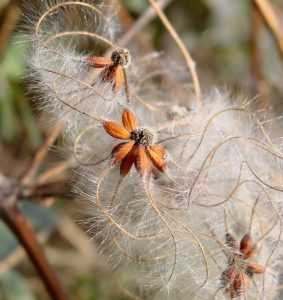
The seeds of Clematis vitalba
The leaves of clematis take on varied forms. They can be simple or divided into leaflets, irregularly cut. They have a rather light, delicate appearance. Those of Clematis armandii are tough and shiny, with well-marked veins. The edge of the leaflets is sometimes dentate, but can also be smooth. Most clematis cultivated in gardens are deciduous. However, a few species, like Clematis armandii, are evergreen.
The clematis bears very characteristic decorative fruits. These are achene extended by a long feathery style, giving them extreme lightness.
Most clematis are quite hardy, often down to -15 or -20 °C. The least hardy are the cirrhosa clematis.
To simplify, clematis are divided into three groups:
- Early flowering clematis. They bloom on the wood of the previous year. This includes Clematis alpina, Clematis montana, and Clematis macropetala, as well as the evergreen varieties, like Clematis armandii and Clematis cirrhosa.
- Early flowering clematis with large flowers. They bloom in spring on the wood of the previous year, then in summer on the shoots of the year. Clematis ‘Nelly Moser’, Clematis ‘Dr Ruppel’, and Clematis florida, for example, belong to this group.
- Late flowering clematis with large flowers. They bloom in summer on the wood of the year. This includes Clematis ‘Jackmanii’, Clematis terniflora, Clematis viticella, Clematis tangutica, and herbaceous clematis.
 Clematis bear flowers of very varied shapes!
Clematis bear flowers of very varied shapes!
Botanical species
This is the wild clematis of our region. It is easily found in France, in forest edges and hedges, which gives it the name “Hedge Clematis”. It bears fragrant white flowers, followed by feathery fruits. Its long and flexible stems allow it to be used in basketry.
- Clematis montana
Native to the Himalayas and China, Clematis montana is a particularly vigorous and early flowering species. Its foliage is covered in spring with countless small white flowers. Notably, its variety ‘Mayleen’ has a generous pink flowering.
- Clematis viticella
A superb clematis that offers a long blue or purple flowering throughout the summer. Its flowers are small and solitary. It has given rise to many hybrids, such as ‘Mme Julia Correvon’ or ‘Étoile violette’. Discover Pierre’s article on our blog!
- Clematis alpina
Like Clematis montana, the Alpine clematis is an early flowering species. Its flowers take the shape of bells, in blue-violet colour. Once flowering is finished, it bears very decorative feathery fruits.
Read also
10 climbing plants ideal for fencesThe main varieties of clematis
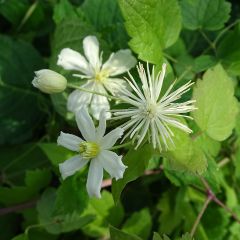
Clematis fargesii Summersnow
- Flowering time August to October
- Height at maturity 5 m
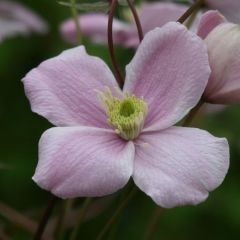
Clematis montana Mayleen
- Flowering time June
- Height at maturity 8,10 m

Clematis jackmanii - Clematis vine
- Flowering time July to October
- Height at maturity 3 m
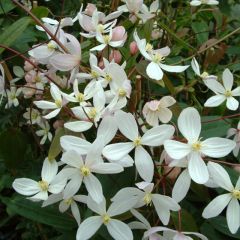
Clematis armandii Apple Blossom
- Flowering time April, May
- Height at maturity 4 m
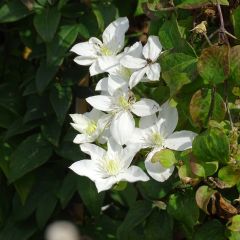
Clematis integrifolia Baby Star 'Zobast'
- Flowering time June to October
- Height at maturity 1,50 m
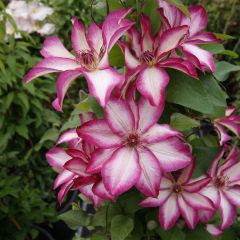
Clematis Picotee
- Flowering time June to October
- Height at maturity 2 m
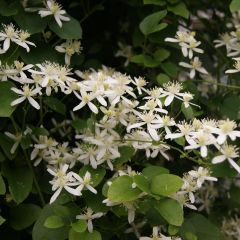
Clematis terniflora
- Flowering time September to November
- Height at maturity 4 m
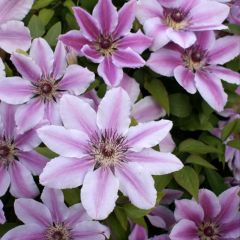
Clematis lanuginosa Nelly Moser
- Flowering time June to October
- Height at maturity 3 m
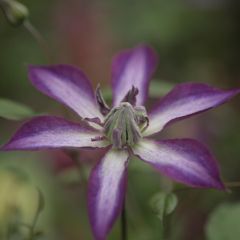
Clematis viticella Astra nova
- Flowering time July to October
- Height at maturity 2,50 m
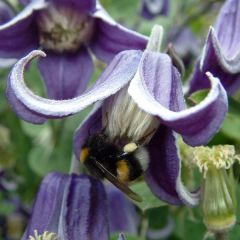
Clematis diversifolia Fascination
- Flowering time July to September
- Height at maturity 1,50 m
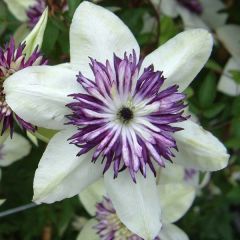
Clematis florida Sieboldii
- Flowering time June to August
- Height at maturity 2,50 m

Clematis flammula Aromatica
- Flowering time August to October
- Height at maturity 1,50 m

Clematis My Angel - Golden Clematis
- Flowering time August to November
- Height at maturity 3 m
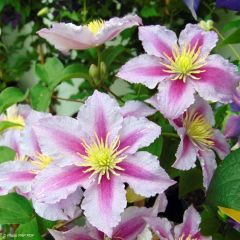
Clematis patens Piilu
- Flowering time June to November
- Height at maturity 2 m
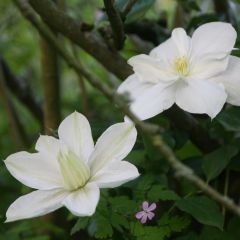
Clematis patens Madame Lecoultre
- Flowering time July to October
- Height at maturity 2,50 m
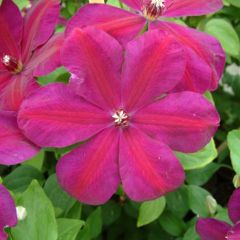
Clematis x patens Westerplatte
- Flowering time July to October
- Height at maturity 2 m
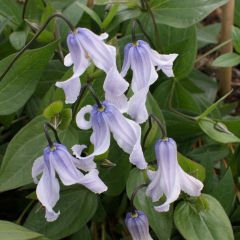
Clematis Twinkle
- Flowering time June to October
- Height at maturity 1 m

Clematis texensis Princess Diana - Scarlet Leather Flower
- Flowering time September to November
- Height at maturity 1,50 m
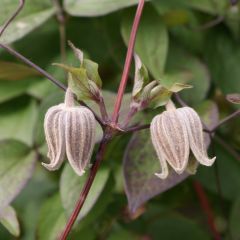
Clematis fusca
- Flowering time July to October
- Height at maturity 1,50 m
Discover other Clematis
View all →Available in 0 sizes
Available in 0 sizes
Available in 1 sizes
Available in 1 sizes
Available in 1 sizes
Available in 1 sizes
Available in 1 sizes
Available in 1 sizes
Available in 1 sizes
Available in 1 sizes
Planting Clematis
Where to plant?
Clematis is a fussy plant: you need to find the spot that will please it! It enjoys having its head in the sun and its feet in the shade. It particularly requires significant brightness. Place it in full sun alongside perennials or small bushes that will shade its base. However, some hybrids, such as Clematis ‘Nelly Moser’, should be planted in a slightly shaded position. In full sun, they would lose the intensity of their colours!
Clematis absolutely needs a deep soil, as its powerful roots extend far into the ground. Shallow or compacted soils will not suit them, which is why we recommend working the soil deeply before planting to loosen and aerate it.
Clematis prefers rich, humus-bearing soils. If your soil is poor, you can enrich it with compost. The soil should remain moist, but be well-drained, as it hates excess moisture (especially in winter), just as much as drought. It will also appreciate being planted out of the wind. Wind could damage its particularly fragile stems. Avoid overly confined situations (for example, squeezed between a wall and other plants), which are conducive to the development of fungal diseases. Clematis is demanding: if it doesn’t thrive, move it!
You can also plant it in a pot and place it on a balcony or terrace. For this use, choose the most compact varieties! Finally, know that you are not obliged to make your clematis climb; you can also let it cover the ground or a bank! Thus, the variety ‘Robert Brydon’ is a good ground cover that forms a carpet of purple flowers.
Also read our article How to fail at planting your climbers?
When to plant?
Planting is possible all year round, avoiding severe frost or extreme heat, but the ideal time is to install it in spring.
How to plant?
Prepare a support. Unlike ivy, which clings directly to house walls with its climbing roots, clematis needs a trellis to wrap its tendrils around and climb.
- Soak the root ball in a basin of water
- Dig a deep planting hole
- Add a drainage layer at the bottom of the hole
- Mix garden soil with potting soil and fertiliser
- Place the root ball at an angle, leaning towards its support
- Water generously and guide the stems towards the support
For more details and advice, check our dedicated sheet: Planting Clematis.
You can mulch with pine bark to keep the soil cool. We also recommend planting perennials next to the base to protect it from the sun. Continue to water in the weeks following planting. And beware of slugs or snails that might nibble on the young plants! You can also plant clematis in a pot.
Follow our video tips for planting clematis!
Read also
10 climbing plants for full sunHow to care for your clematis?
Apart from pruning, clematis require quite little maintenance. You can regularly remove faded flowers, except for varieties that produce decorative fruits. Add a bit of compost at the beginning of spring. Water your clematis only in the height of summer, avoiding watering directly at the base of the stems. At other times, there is no need to water, except in cases of drought. Be especially careful of excess moisture: avoid waterlogging the soil!
How to combat common clematis diseases?
Hybrid varieties with large flowers are more susceptible to diseases than others. They are much more fragile than those with small flowers. The main problem with clematis is caused by a fungus, Ascochyta clematidina, which can devastate a plant in just 24 hours! Your clematis seemed healthy and vigorous, it was even about to bloom, but suddenly its leaves start to dry out! Before you have time to react, it is already completely wilted… This disease is a real scourge, preventing sap from circulating, leading to tissue death. Cut the plant back to the base of the stems, a few centimetres below the soil (as the fungus lives on the surface), and replace the soil around the stems, several centimetres deep, with healthy, uncontaminated substrate. The plant can regrow from the base. Limit watering: moisture encourages this disease.
Clematis are susceptible to gastropods (slugs and snails), which delight in munching on young shoots! You can protect your newly planted clematis by placing ash or wood chips around the base to create a barrier. They can also be attacked by aphids. If you notice that the leaves are curled and sticky, spray with black soap or a solution based on pyrethrum.
The best practices for pruning your clematis
By pruning your clematis, you will achieve a well-ramified plant, with a more compact habit, and encourage flowering (provided you do it at the right time!) First and foremost, disinfect your pruning shear to avoid transmitting diseases from one clematis to another. When working on affected plants, dispose of the stems and leaves you cut.
Prune early-flowering and evergreen varieties at the end of spring, around May, once flowering is finished. Perform a very light pruning. If you intervene too early, between autumn and early spring, you risk cutting the branches that will bear flowers, thus limiting flowering! These varieties can even do without pruning.
For other later and large-flowered varieties, prune before the resumption of growth, between February and March. You can prune them more severely! Don’t hesitate to cut back every other branch to 30 or 40 centimetres above the ground. Also remove any dead shoots. A second pruning can be done after flowering.
→ Learn more in our advice sheet: Why isn’t my clematis flowering? and in our tutorial: winter pruning of clematis.
Techniques for Propagating Clematis
You can multiply your clematis by propagating them by cuttings or layering. We recommend propagation by cuttings, which is the simplest technique. As for sowing, it is tricky to carry out, and the seeds can sometimes take a very long time to germinate.
Introduction to clematis propagation by cuttings
You can take cuttings of clematis at the end of spring, in June or July.
- Start by preparing a pot: place a layer of gravel or clay balls at the bottom for drainage, then fill the pot with a mixture of potting soil and sand.
- Next, cut a stem about fifteen centimetres long, using a knife or pruning shear.
- Remove the leaves located at the base of the stem, if there are any.
- Leave only a few leaves on the cutting, then replant it in the pot and firm the soil around the stem.
- Water and cover the pot with clear plastic or a cut plastic bottle to maintain a humid atmosphere.
- Place your pot under a frame, out of direct sunlight.
You will need to wait until the following spring to plant the clematis in the ground.
Layering clematis
You can layer clematis. This technique will allow you to quickly obtain new plants. Act in summer, around August. Layering is done by bending down on lignified branches.
Layering clematis is preferably done in a pot. To facilitate the operation, choose a pot that is wide enough (at least 15 cm in diameter).
- Place a layer of gravel at the bottom for drainage, then fill it with potting soil.
- Choose a long stem, cutting the leaves so that only those at the end of the branch remain.
- Make a slight incision on the bark, on the area you will bury.
- Then, place it in the soil and cover it with substrate.
- Raise the end of the stem and keep it upright with a stake.
- Firm the soil and water.
For more information, read our practical guide on the propagation by cuttings of clematis.
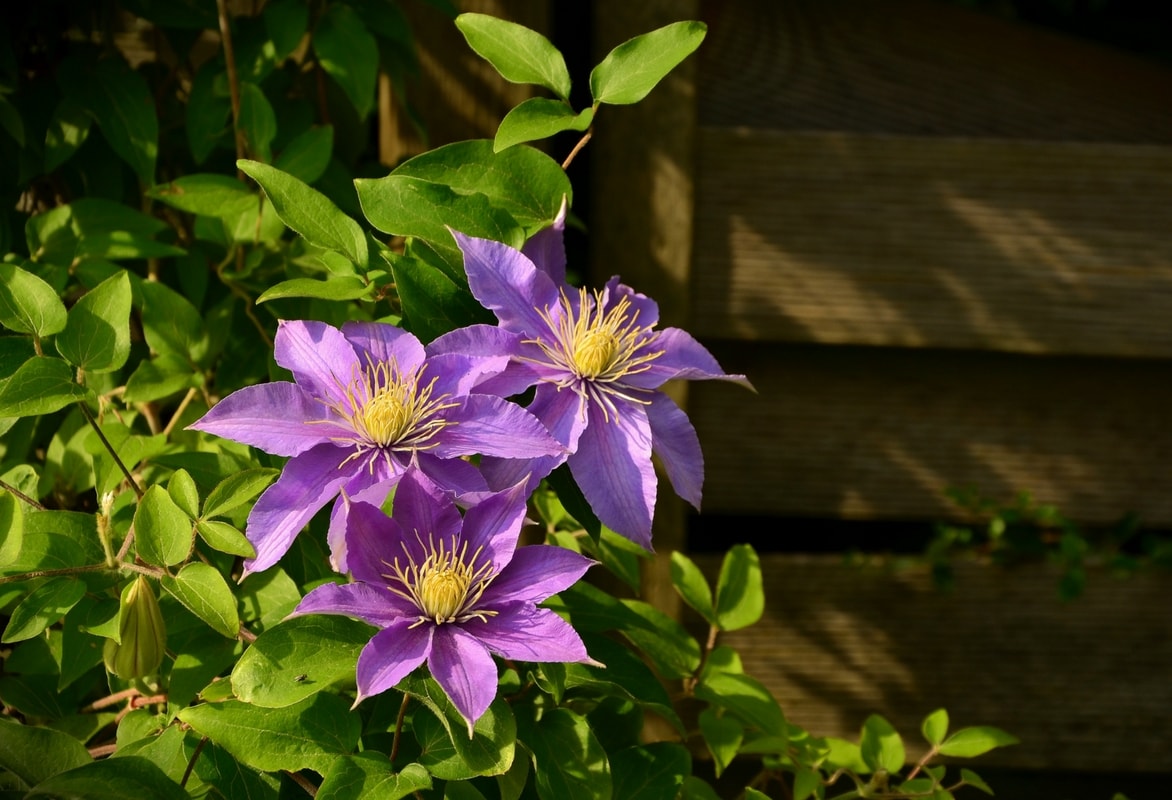
Associating Clematis: General Tips
Clematis pair wonderfully with roses, whether they are climbing or bush varieties. Together, they create a romantic atmosphere, full of softness and delicacy. Many varieties offer blooms in pastel shades of pink, white, or mauve. Discover Clematis montana ‘Mayleen’: it bears a multitude of soft pink flowers in spring, adding much charm to the garden. You can also pair the white flowers of the clematis ‘Summersnow’ with the pale pink blooms of the climbing rose ‘Coral Dawn’.
In any case, we recommend planting other perennials around the clematis: they will protect the base from the sun and help keep the soil cool. Take the opportunity to install some hardy geraniums. If the base of your clematis is bare or lacking flowers, they will certainly add some colour!
Feel free to mix different varieties of clematis! Discover our collections. You can pair them with other climbing plants such as akebias or jasmines.
Let them climb in your trees and shrubs… If you were growing them for their decorative foliage, they will now have the added interest of being covered in a multitude of star-shaped flowers! You can also let them climb in your fruit trees, for example by planting a clematis montana at the base of an apple or cherry tree.
The most compact varieties are perfectly suited for container cultivation. They will bring colour to your terraces and balconies! Plant them in large pots with some perennials or bulbous plants, such as hyacinths, anthemis, or verbenas. If you have a shaded area, pair your clematis with the decorative foliage of ivies or ferns.
Herbaceous clematis fit very easily into borders. You can combine Clematis heracleifolia with the light foliage of grasses and the flowers of asters.
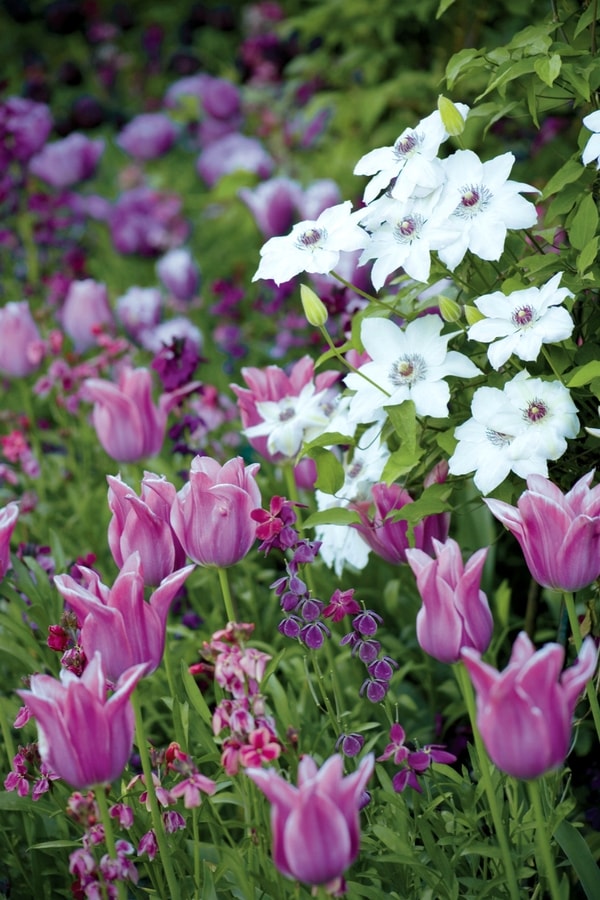
The clematis ‘Snow queen’ and the tulip ‘Ballade’! (Copyright MAP Clive Nichols)
For more specific pairing ideas based on various situations, discover our tips: Clematis – 7 successful pairing ideas and Pairing herbaceous clematis.
Useful resources
- The most beautiful range of clematis is with us!
- We offer you many tips on the following topics: Choosing your clematis – Planting clematis – Planting clematis in pots – How to train and support clematis – Evergreen clematis: how to plant and cultivate – Pruning and maintaining clematis – Caring for clematis diseases – Propagating clematis – Combining clematis – Winter pruning of clematis – How to prune winter-flowering clematis? – How to easily multiply clematis?
- An article by Pierre on our blog, Clematis viticella, the beautiful Italian!
- Our video tips for planting a clematis;
- Our advice sheet: Clematis montana, the best varieties; Planting an herbaceous clematis; Choosing an herbaceous clematis
- Our advice sheets: 7 clematis with unique flowering; 7 clematis with continuous flowering; the most spectacular clematis; Clematis with bell-shaped flowers: our top 5
- Our advice sheets: 7 tall clematis; 7 clematis perfect for pots
- An article by Didier Willery, Clematis with large flowers, guaranteed spectacle! published in L’Ami des jardins et de la maison (June 2012)
- Also check out the book: Clematis, how to use them well in the garden, by Didier Willery and Arnaud Travers, ed. Ulmer, 2010
- Learn more about clematis viticella with: the red viticella clematis, blue viticella clematis, pink viticella clematis and the most beautiful viticella clematis, 7 purple or red viticella clematis
- Advice sheet: 5 very hardy climbing plants, 5 climbing plants that won’t damage walls
- Clematis by season: 6 climbing plants with winter flowering; 6 clematis with winter flowering; 7 clematis with spring flowering; 8 clematis with autumn flowering
- Clematis by flower colour: 8 climbing plants with blue flowers that you must have in the garden, 6 climbing plants with white flowers that you must have in the garden, 8 climbing plants with red flowers, 7 climbing plants with pink flowers; Herbaceous clematis with pink flowers; Discover 9 herbaceous clematis with magnificent blue flowers; 5 herbaceous clematis with white flowers; Herbaceous clematis with purple and mauve flowers: our top 5.
- Our advice sheet: 7 clematis for a natural garden, 6 herbaceous clematis to flower a border; 6 climbing plants ideal for shading a terrace; 7 clematis with double flowers for a spectacular flowering
Frequently asked questions
-
My clematis is suddenly wilting! What should I do?
It is likely suffering from the disease caused by the fungus Ascochyta clematidina (also known as Phoma clematidina). This impressive disease causes the sudden wilting of stems in no time. It is important to avoid the combination of heat and humidity, which are conducive to the development of this disease. We recommend cutting the stems a few centimetres below soil level. The plant should regrow from the base. Since this fungus infects the soil, it is necessary to remove the soil to a depth of about ten centimetres and replace it with healthy substrate.
-
My clematis looks wilted!
The soil is probably too wet. Limit watering, and especially avoid watering directly at the base of the stems. If you have applied mulch, remove it. Consider moving the plant to a more draining soil. Waterlogged soil can cause the roots to rot!
-
The flowers of my clematis are fading and losing their brightness!
If they take on green or very pale hues, this may be due to temperatures that are too low during the growth of the flower buds. They should regain their usual hue as the season progresses. This problem mainly affects clematis with white flowers (which then turn green) or those that are quite pale. It also happens that large-flowered hybrids take on duller hues in the sun. We recommend, for example, planting Clematis ‘Nelly Moser’ in partial shade.
-
The leaves of my clematis are curling up and becoming sticky!
The culprits are aphids. They pierce the leaves, causing their deformation and promoting the development of diseases. Spray with black soap or a solution based on pyrethrum.
-
My clematis isn't flowering... or is flowering too little!
If your clematis is struggling to flower, it means the growing conditions are not suitable for it. The soil should be cool but well-draining. Ensure that its base is shaded, while the rest of the plant receives enough light! Flowering can also be hindered if you prune the clematis at the wrong time, removing the stems on which the flowers should bloom. This happens if you prune early-flowering clematis (for example, Clematis montana or alpina) or evergreen varieties in winter or early spring. You risk preventing the flowers from appearing by cutting the branches on which they should bloom. Conversely, pruning at the right time will encourage the development of flower buds and make the flowering even more abundant.
-
The flowers of my clematis are different from what was expected!
Some large-flowered hybrids bear flowers that are double in spring and then single in autumn. Don't be surprised if a double-flowered variety gives you single flowers in summer or autumn!
- Subscribe!
- Contents































